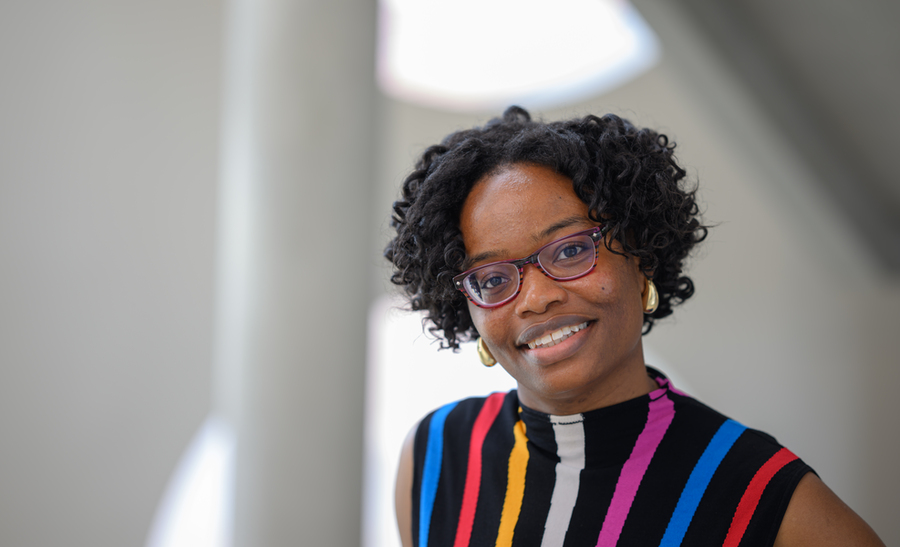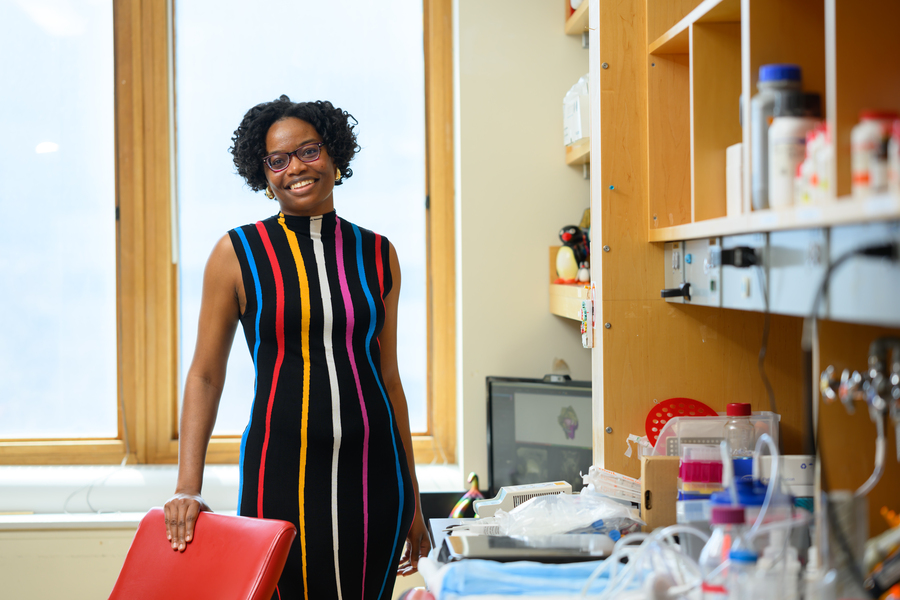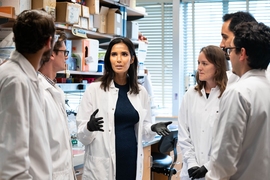Watching her uncle play a video game when she was a small child started Shaniel Bowen on her path to becoming a biomedical engineer. The game, “Metal Gear Solid 2,” introduced her to exoskeletons, wearable devices that enhance physical abilities.
“The game piqued my interest when it started showing and discussing exoskeletons,” Bowen says. “I went to the library soon after to learn more about it. That was when I first learned about biomedical engineering and became interested in pursuing it as a profession.”
Fast-forward to her senior year at the University of Connecticut. Bowen and an interdisciplinary team of biomedical, electrical, and computer engineers developed a device using musculoskeletal modeling and computer-aided design that could help people with leg weakness to stand. The system provided just enough assistance that the person would still use their own muscles, strengthening them with repeated use. Bowen was on her way to creating her own exoskeleton.
That changed, however, when she was starting graduate school and was diagnosed with ovarian torsion caused by a large ovarian teratoma.
Not only was she dealing with a serious medical condition, but as a Black woman raised by Jamaican immigrants, she was personally confronted with inequities in health care that result in discrepancies in treatment.
“Like many Black, Indigenous, and people of color (BIPOC) women, I was initially apprehensive and discouraged from seeking medical care for a long time, which led me to trivialize my symptoms,” Bowen says. “A serious gynecological condition that required surgery was almost left untreated.”
After her surgery, Bowen pivoted from her work in human movement and biodynamics to biomedical engineering focused on women’s health.
“I became interested in applying my engineering expertise to women’s health issues in order to gain a better understanding of various pathologies from a biomechanics perspective and to bring awareness not only to individuals in my field but also to women who suffer from or may be at risk for these conditions,” she says.
During her doctoral program, Bowen studied the effects of age and pelvic reconstructive surgery on female pelvic anatomy and function using computational modeling. She received a Ford Foundation Fellowship from the National Academies of Sciences, Engineering, and Medicine to study the biomechanical processes involved in pelvic organ prolapse (POP), a common condition that can cause extreme discomfort, sexual dysfunction, and incontinence. POP can be surgically corrected, but the repair often fails within five years, and it is unclear exactly why. Bowen’s research set out to develop a tool to better assess the biomechanics of such failures and to prevent them.
“It is hoped that our findings, based on postoperative imaging and clinical data, will encourage longitudinal trials and studies that incorporate both clinical and engineering approaches to better understand POP surgeries and pelvic floor function and dysfunction following pelvic reconstructive procedures,” she says.
After earning her PhD at the University of Pittsburgh, Bowen received multiple offers to do postdoctoral research. She chose the MIT School of Engineering’s Postdoctoral Fellowship Program for Engineering Excellence and started work in the Edelman Lab in September 2023.
“The program and my principal investigators were the most supportive of me exploring my research interests in women’s sexual anatomy and health,” she says, “and learning experimental methods from the ground up, given that my primary experience is computational.”
Elazer Edelman, the Edward J. Poitras Professor in Medical Engineering and Science, director of MIT’s Institute for Medical Engineering and Science, professor of medicine at Harvard Medical School, and senior attending physician in the coronary care unit at Brigham and Women’s Hospital in Boston, speaks admiringly of Bowen and her research.
“I love working with and learning from Shaniel — she is an inspiration and creative spirit who is treading in new spaces and has the potential to add to what we know of health and physiology and change our practice of medicine,” says Edelman.
The Edelman Lab was “one of the few,” Bowen says she found “with a longstanding commitment to public outreach,” which has been a consistent endeavor throughout her academic career.
For nearly 10 years, Bowen has volunteered in mentoring and STEM outreach programs for students of all ages — including at her old high school, at the universities she has attended, and in underserved communities. Currently, Bowen devotes a portion of her time to outreach, health promotion, and education, primarily focusing on women’s health issues.
“My research collaborators and I have worked toward removing the stigma and misconceptions around women’s anatomy and health,” she says, explaining that helping young women from underserved communities to be more comfortable with and better informed about women’s anatomy and health is “integral to health equity and inclusion.” Such work also encourages young women to consider careers in STEM and women’s health, she says.
“It is imperative that women of diverse experiences and perspectives get involved in STEM to develop the next generation of scientists and advocates to improve the treatment of health conditions for all women.”
Part of Bowen’s postdoctoral research involves complementing her computational abilities by acquiring and improving her skills in biochemistry and cell biology, and tissue mechanics and engineering. Her current work on how clitoral anatomy relates to sexual function, especially after gynecological surgery, explores a topic that has seen little research, Bowen says, adding that her work could improve postoperative sexual function outcomes.
The MIT Postdoctoral Fellowship Program for Engineering Excellence — which, while emphasizing research, also provides resources and helps fellows to build a professional network — has provided an excellent system of support, Bowen says.
“It has really helped me learn and explore different career paths while having a great support system of fellows and staff that have provided continued motivation and life advice throughout the ups and downs of navigating through my postdoctoral training and job search,” she says.











